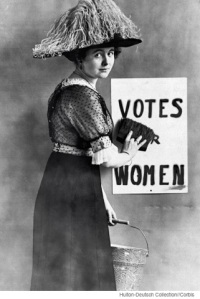In this inspiring and provocative essay, author Theo Anderson explores the similarities between the push to reform campaign financing and overturn Citizens United, and the suffragette movement of the early 20th century. Read the whole piece here, or an abridged version below:
In truth, the momentum for reversing Citizens United was never going to come from the White House, much less from Congress. Both are too deeply enmeshed in the system to invest much effort in reforming it.
The energy to defeat the ruling will come, if it comes from anywhere, from old-fashioned grassroots activism. And on that front, the outlook is more promising than you might guess. There’s good news and bad news, and some more good news.
The first piece of good news is that Citizens United isn’t a partisan issue: a substantial majority of voters favor imposing limits on the influence of money and lobbyists in American politics (poll).
The bad news is that reversing Citizens United is only the first step if we’re serious about addressing corruption in American politics. To believe that reversing the ruling a panacea is to believe that “our democracy was fine and Citizens United broke it.
But of course, the democracy was already broken,” as Lawrence Lessig, who directs the Edmond J. Safra Center for Ethics at Harvard, has observed. He argues that the Left and the Right can agree that the influence of money is a major reason for the corruption of our politics, and calls for them to join forces and replace the current system with public financing and limited private donations.
The second piece of good news is that there is a well-marked path toward achieving both the immediate goal of overturning Citizens United and the broader goal of replacing our current system of campaign finance. It involves building on the accomplishments of campaigns at the state and local levels.
Building on state-level activism and incremental progress – with the ultimate aim of passing a constitutional amendment that addresses both Citizens United and the general corruption of our politics – has an important precedent. It was the strategy used by the woman suffrage movement a century ago, at a time when passing an amendment that guaranteed women the right to vote seemed about as likely as purging corruption from our politics seems today.
The state of Washington passed woman suffrage legislation in 1910, and several states followed suit over the next two years (AZ, CA, KS, OR). In 1912, woman suffrage became a plank in the Progressive Party platform. But despite this apparent momentum, there was little movement toward the goal of passing a constitutional amendment during the next four years.
In 1916, Carrie Chapman Catt – head of the National American Woman Suffrage Association –called on NAWSA’s state chapters to engage in a “red-hot, never ceasing campaign” to pressure state legislatures. That campaign – along with the agitation of a more militant faction of suffragettes – turned the tide in the last third of the decade. Several more states granted at least limited suffrage in 1917 and 1918, and the U.S. Senate passed the woman suffrage amendment in 1919. It was ratified by three-fourths of the states the following year.
At least two relevant morals can be drawn from this history. One is that the leaders of the political parties might be pressured into doing the right thing, but they will rarely lead the way.
The other moral is that it’s impossible to know how far a movement is from achieving its goal until that goal becomes reality. When a wave of Western states began passing woman suffrage legislation in 1910, it had been fourteen years since the last state, Idaho, had done so. When suffrage became part of the Progressive Party’s platform in 1912, it must have seemed that victory wasn’t far off. Yet it took seven more years of struggle, including a period when the momentum of 1910-1912 seemed to fade, to reach the goal. And no one knew, at any point along the path, when or if the constitutional amendment would ever pass.
So here’s a final piece of good news: genuine reform might be closer than it seems.
The one certain thing is that, as Barack Obama used to say, we are the change that we seek. It’s now clear that by “we,” he meant you and me. What sounded like a promise in 2008 was actually a warning: if we don’t do it, it won’t get done. The president, even if he has the inclination, doesn’t have the power. And Congress is so corrupt that it can’t even begin to think about how to reform itself.
Yet, for all that, it’s just possible that we’re on the brink of something big. It might be ten years away. It might be a year away. No one knows.

